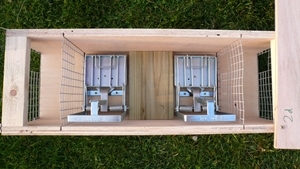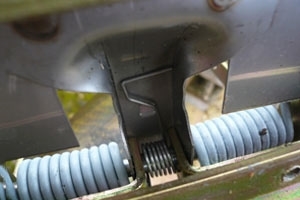 DOC traps are a family of spring traps (killing traps) designed by the Department of Conservation (DOC) in New Zealand and manufactured by CMI Springs. The intention was to replace older spring traps (including Fenn traps) with a new generation of traps that would meet humaneness standards based on emerging international agreements such as the Agreement on International Humane Trapping Standards (AIHTS) to which the UK is a signatory.
DOC traps are a family of spring traps (killing traps) designed by the Department of Conservation (DOC) in New Zealand and manufactured by CMI Springs. The intention was to replace older spring traps (including Fenn traps) with a new generation of traps that would meet humaneness standards based on emerging international agreements such as the Agreement on International Humane Trapping Standards (AIHTS) to which the UK is a signatory.
There are three models in production, the DOC 150, 200 and 250. The model numbers refer to the approximate width of the tunnel in millimetres that traps must be placed in and the actual trap dimensions are detailed in Table 1. All three sizes are approved in the UK (see Table 2 for the range of species for which each is approved), but only the 150 and 200 are readily available here. The DOC 150 is intended to fit the same tunnel dimensions as the Fenn Mk IV or Springer/Solway No 4 traps, meaning it can be fitted into a pre-existing trap space.
Table 1: Actual dimensions of the three DOC trap models
| Trap |
Height (mm) |
Width (mm) |
Length (mm) |
| DOC 250 |
215 |
215 |
170 |
| DOC 200 |
180 |
180 |
130 |
| DOC 150 |
140 |
140 |
130 |
However, note that because the DOC trap must be fixed to a rigid base and requires an inner baffle(s), some adjustment of the tunnel may still be necessary; for most trappers, the construction of a new dedicated box has proved to be the best way forward to ensure appropriate length and height. Likewise, the 200 is designed for similar tunnel dimensions to Fenn Mk VI and Springer/Solway No 6 traps. Readers will note that the width of both traps is similar when set, but the height differs enough that existing Fenn housings may not work.
The 150 and 200 are similar in strength, but because of its larger dimensions the DOC 200 provides more leverage to cock the trap and is easier to set. The 150 has the benefit of a high strike force but in a small package, making it a valuable trap for UK applications.
Table 2: Summary of tunnel requirements and components for DOC 150 and 200 traps
| Tunnel type |
Tunnel materials |
Species approved for |
Baffle materials |
No. of baffles |
Max baffle hole size |
No. of excluders |
Excluder materials |
Excluder design |
| Single-entry |
Natural or artificial |
Stoat
Weasel
Rat
Grey squirrel |
Any suitable material |
1 |
65mm square or core drilled |
1 |
Any suitable material |
Operators' discretion to suit local circumstances |
| Run-through |
Natural or artificial |
Stoat
Weasel
Rat |
Any suitable material |
2 (1 either side of trap) |
51mm square or core drilled |
2 (1 either side of inner baffle for each tunnel entrance) |
Any suitable material |
Operators' discretion to suit local circumstances |
The DOC trap treadle plate design is large (almost twice the length of a Fenn-type trap), so when combined with the required baffle configuration and position in relation to side of tunnel, it ensures that animals cannot skirt around it and are less able to jump over it. Underneath the treadle plate is a small secondary spring which maintains the height of the treadle (see photo below). The factory setting of the trap is such that it will only fire when a weight of 80g or more is applied to the treadle. This useful feature reduces false trips caused by mice, voles or shrews, and prevents the progressive lowering of the treadle by repeated passage of such animals until it eventually trips. It cannot, however, prevent the trap firing if small mammals arrive in twos or threes, or if they jump about on the treadle plate, which appears to be a frequent occurrence in both the uplands and the lowlands.
Background
Weasels and stoats were imported to New Zealand during the 1880s, and began to have a very serious impact on New Zealand's native bird fauna. To combat this, the Department of Conservation adopted the tunnel trapping methods developed during the 1950s for game management in the UK.
However, the recent international debate on humaneness in animal trapping, particularly in the context of fur trapping, had considerable influence on the New Zealand authorities. Field experience and unpublished tests by Landcare in New Zealand (Poutu & Warburton, 2005) indicated that Fenn Mk IV traps did not kill stoats within the sort of time-frame discussed at international levels. This led to the development of alternative trap designs which would meet such targets. These were designated DOC traps and made in three sizes to match different overlapping ranges of target species.
It was apparent from laboratory tests and early field trials with DOC traps that positioning of the animal when it depressed the treadle plate contributed significantly to the humaneness of the outcome. To ensure this in use, tunnels were equipped with double entry baffles at each open end. These consisted of two mesh screens, with apertures cut to allow entry by target animals. The size and position of the apertures ensured a slow approach and positioned the animal optimally. Together the combination of trap and tunnel have been shown to pass international humaneness standards agreed between the EU and fur-trading countries.
Features
The three trap models differ only in size and power, the DOC 150 being the smallest and the DOC 250 the largest. The DOC 150 has the same dimensions as a Fenn Mk IV, but similar power to the DOC 200. Because of its larger dimensions, the DOC 200 is actually the easier to set, but obviously appreciably bulkier. On the basis of preliminary trials we would recommend it over the DOC 150 where grey squirrels are the chief target (you might also consider the Kania traps and live-capture cage traps).
 The fundamental design is the same in all three DOC trap models. A single grid-shaped moving jaw is powered by springs from a vertical stand-by position to the horizontal. The trigger is a large treadle plate.
The fundamental design is the same in all three DOC trap models. A single grid-shaped moving jaw is powered by springs from a vertical stand-by position to the horizontal. The trigger is a large treadle plate.
A small secondary spring underneath the treadle plate guards against false trips caused by the repeated passage of small non-target mammals such as mice, progressively lowering the treadle until it finally trips. This has been a common problem with Fenn-type traps. The secondary spring in DOC traps is designed to restore treadle height after each disturbance by a small non-target.
All three models are very powerful and could cause serious human injury. Nevertheless, because they are fixed into their tunnels, they are also easy to set, and there is no reason to place your fingers at risk!
Humaneness
A generic limitation with Fenn traps and other body-grip traps, including rotating-jaw traps such as the Conibear and Magnum, is that they kill by striking and crushing the body of the animal. The most humane death would result from a strike to the head sufficient to fracture the skull, causing instant irreversible loss of consciousness. This rarely happens in body-grip traps, in which the best outcome is that the body is gripped in the chest or neck, with brain death following as a consequence.
In other trap types, like the Kania and the DOC series, a head-strike is the intended norm. In 2008 we conducted field trials to compare the DOC 200 with its designated single-entry tunnel against Nº 4 Springer traps (Fenn copies) in customary run-through tunnels to represent current practice. DOC 200 traps almost always struck squirrels across the head, or head and neck, while Springer traps almost never struck the head.
Instructions
We put together guidelines on the use and approval of DOC traps, which you can download here.